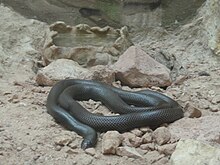Atractaspididae
| Atractaspidinae | |
|---|---|
 |
|
| Atractaspis engaddensis | |
| Scientific classification | |
| Kingdom: | Animalia |
| Phylum: | Chordata |
| Class: | Reptilia |
| Order: | Squamata |
| Suborder: | Serpentes |
| Family: | Atractaspididae |
| Subfamily: |
Atractaspidinae Günther, 1858 |
| Synonyms | |
|
|
The Atractaspidinae are a subfamily of snakes found in Africa and the Middle East, commonly called mole vipers, stiletto snakes, or burrowing asps. Currently, 12 genera are recognized.
This subfamily includes many genera formerly classed in other families and subfamilies, on the basis of fang type. It includes fangless (aglyphous), rear-fanged (opisthoglyphous), fixed-fanged (proteroglyphous), and viper-like (solenoglyphous) species. Early molecular and physiological data linking this subfamily to others were ambiguous and often contradictory, which means the taxonomy of this subfamily has been highly contentious. The nominate family, Atractaspididae, has itself been moved to and from other taxa, reinforcing the ambiguity of this subfamily.
This subfamily is found in Africa and the Middle East.
Most of these snakes are inoffensive or far too small to envenomate a person effectively. However, some can inflict severe tissue necrosis; e.g. if the victim's thumb is bitten, the tip of that digit may be lost. Relapses may occur long after the bite.
Very few deaths have resulted from accidents with these snakes, although large individuals of Atractaspis microlepidota and a few other long-glanded species are very likely to be dangerous. Some of the long-fanged species are able to stab their prey (or an unfortunate human) even while their mouths are closed, and the typical grasp used by herpetologists to securely hold venomous snakes is not necessarily safe for this group. This ability to stab sideways even with a closed mouth is the basis for an English name used for some of them - side-stabbing snakes.
...
Wikipedia
